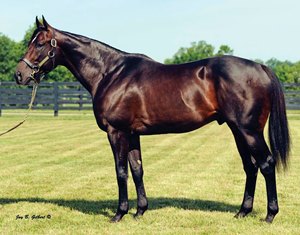Yearling Average Trends Among Top Sires


Among the top 10 leading sires at the Keeneland September yearling sale by average price, three of the stallions have seen their overall yearling average more than triple in value since 2012.
Leading the group by appreciation in value is WinStar Farm's Pioneerof the Nile , whose North American yearling average has grown 238% from $75,689 in 2012 to $255,511 through Sept. 19 of this year. The grade I-winning son of Empire Maker would not have his first crop at racetracks until 2013 and he got off to a slow start, getting one black-type winner in his first crop. Everything would change with the second crop that included future Triple Crown winner American Pharoah , who would earn champion 2-year-old honors for 2014. Pioneerof the Nile's yearling average would nearly double between 2013 and 2015 (see the chart below). He now has 16 (9%) black-type winners to date.
The yearling value of Hill 'n' Dale Farms' Curlin has been on a similar growth curve, producing a 232% jump in average price from $70,448 in 2012 to $233,591. The first runners by the son of Smart Strike and two-time Horse of the Year (2008-09)—like those by Pioneerof the Nile—needed time to show off their abilities. Curlin did not have any black-type stakes winners in his first crop then got five the following year, led by Belmont Stakes (gr. I) winner Palace Malice , and added another 12 in 2014. He now has 28 (8%) black-type winners and an Average Earnings Index of 2.27.
The late Scat Daddy , Ashford Stud's rising star who died suddenly in 2015, is the third stallion to see an appreciation in yearling average in excess of 200% over the past five years. The son of Johannesburg was a second-crop sire in 2012, when he had nine black-type winners. While he was represented by multiple grade I winner Lady of Shamrock and graded stakes winners Handsome Mike and Daddy Nose Best that year, his brightest stars were shining in Chile, where he'd been shuttling. The North American market didn't respond until 2014 when runners like Dacita, El Kabeir, and Frac Daddy began winning graded stakes in the U.S. and Canada. Scat Daddy's yearling average rose into the six-figure range that year to $116,253.
Despite producing averages well north of $200,000 back in 2012, the yearlings by leading sires Tapit and War Front have still seen remarkable growth in value since then.
Claiborne's War Front, who was a third-crop sire in 2012, has had his yearling average grow 168% from $230,733 five years ago to $618,409 so far this year. The son of Danzig has 52 (15%) black-type winners to date, of which 30 are graded/group winners.
The North American yearling average for Gainesway's Tapit has produced a similar spike, jumping 150% from $261,000 five years ago to $651,463 so far in 2016. The son of Pulpit has sired a total of 85 (11%) black-type stakes winners to date, with 53 of those performers winning in graded or group stakes.

